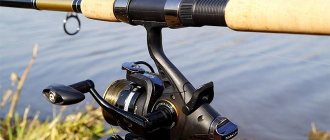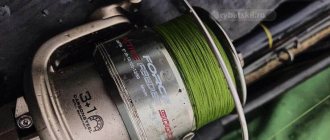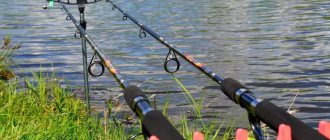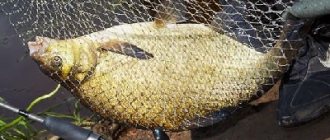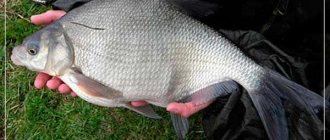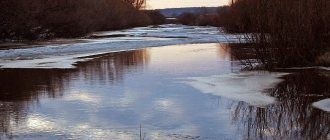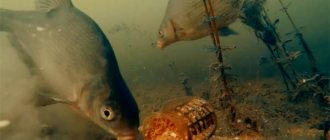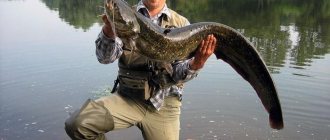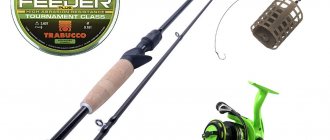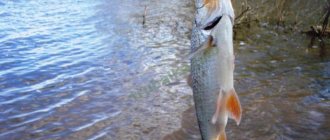Spring passes its equator and for most anglers the season of the most promising and productive fishing begins, among which fishing for bream in May on a feeder especially attracts the increased attention of lovers of bottom hunting methods. Fish activity is associated with a sharp increase in water heating, stimulating schools to move towards spawning grounds. And the weather acquires a more stable background, bringing night and day indicators closer together, and also maintaining atmospheric pressure in narrow ranges for several days without changes, without sudden changes and jumps. This undoubtedly favors fishing, and even more so for such capricious fish as bream.
Although schools of feeding bream try to stay at long distances from the coastlines, the shallow zones saturated with nutritious organisms from the heated waters force them to approach water areas where they can get a trophy from the shore using feeder tackle. Anglers who are keen on feeder fishing should definitely delve into the topic of bream fishing on a feeder in May. After all, this short period of time is rightfully considered the high season of fishing, when most often you can get a trophy that responds to various types of baits, without being particularly capricious or overdoing it with taste, and even showing a stable bite. And we will talk further about the nuances of this kind of fishing.
How does bream behave in May?
In May, bream is already completing preparations for the spawning period. Most often, the second half of the month will be devoted to reproduction and the fish will have no time to search for food. But the vestibule of the spawn guarantees increased bite. In the spring, schools of bream are characterized by a high concentration of individuals of different sizes, prowling through reservoirs in search of promising feeding zones. The fish finds such areas on heated shallows and, unlike the rest of the open water period, and indeed the entire under-ice season, bream can be confidently searched for in shallow waters 1–3 meters deep, where it is quite active and not at all timid, gaining the last calories before the period reproduction.
Fishing strategies differ from the summer and autumn periods - catching bream in May with a fishing rod and feeder gear shifts to the banks and spits, where the bottom is dotted with mollusks or young growth that begins to grow intensively in warm water. When choosing bait, May bream are not picky and actively respond to both animal and plant baits. The easiest way to attract a flock to the fishing zone is with dusty, dark-colored bait with the obligatory presence of sweet ingredients.
Where to look for bream in May
Closer to spawning, the bream comes out to shallow water, where it stays throughout the day, continuing to actively and continuously feed. Fishing for bream in May with a feeder on the river is promising at the exits from the main channel, where the currents are seriously slowed down, and the area of the river water area gradually turns into extensive and shallow coastal backwaters. A migrating flock will stop in such a place without thinking, especially if the bottom has a solid structure and is covered with a colony of shells. Rare snags and stones will only add promise to the place.
Good fishing in May for bream, on lakes where water areas adjoin dams and embankments, as well as the walls of coastal thickets, which attract fish with young and sweet shoots of new plants. Small fish are less timid and come close to the shores, but trophy bream prefers to stay on the borders of feeding zones, moving into deeper waters if there is any suspicion. Therefore, the tactics for catching large individuals should focus on supplying bait in the water area where a distinct bottom drop begins .
What feeder equipment to use
For spring bream feeder fishing, heavy feeder rods with a length of 3.5 meters or more are suitable, providing stable long-distance casting. They are equipped with power spinning reels of 3000–4000 units, preferably with a baitrunner. After all, round-the-clock fishing will be reliable with the presence of safety gear with this functionality, which will save the loss of gear in the event of a sudden bite of a large trophy. The reel is loaded with a braided line of 0.12-0.15 mm, which has low windage and high information content, using feeder installations in the form of an asymmetrical loop or a paternoster familiar to most tying fans.
Rectangular mesh metal or plastic feeders are used in installations. The weight of the feeder varies depending on the intensity of the current or its absence from 60 to 120 grams. The mesh cell is selected based on the strength of the water current and the fraction of bait used. The size of the cell should release the complementary food in the form of turbidity, creating a nutrient trail and be washed out at least 10–15 minutes after casting. As a rule, a monofilament leash has a diameter of at least 0.12 mm. Depending on the activity of the fish, its length ranges from 30 to 100 cm.
Important! The more passive the bream, the longer the leash.
It is reasonable to use the technique of installing a monofilament or fluorocarbon shock leader in the rig, which saves a large catch at the final stages of fishing, especially if the coastlines do not allow convenient removal of the trophy. The installation ends with a hook, the type of which is selected according to the type of bait. A hook size of 8–12 numbers is almost always sufficient, even for catching a couple of kilogram trophies.
Fishing methods
The methods do not differ radically from the summer or spring periods, remaining unchanged. Bream travel in schools and feed from the bottom, so the methods will be selected accordingly. Which one you choose will depend on the equipment method and approach, but it’s difficult to say that one of them is much better. The choice depends on experience or fishing conditions.
On a float rod
When it comes to float fishing, a long rod wins; a 6-7 meter blank will be just right. A 5 m fishing rod is more versatile.
Rod equipment:
- The main line is 0.20-0.25 mm.
- Leash with a diameter of 0.12-0.15 mm. The material is monofilament or fluorocarbon.
- The reel can be either inertial or inertial-free; the first option is preferable, since this is not a feeder rod and there will be no long casts.
- Hooks are used in sizes from 8-14, in rare cases they knit something larger, in No. 6.
- The distance is selected experimentally, but casting too close is also not worth it.
To the feeder
The feeder is the most common method of spring bream fishing, as it allows long casting and fishing from the bottom. Used in currents and in still water. From April to October, you can use this method without hesitation, since during this entire time it does not lose its relevance.
Having equipped the rod with a marker weight, find promising places - these will be shallows further from the shore, where the water temperature will be higher compared to the holes. Afterwards, 5-6 casts of bait are made (full feeders) to create a feeding spot.
This will allow you to lure fish to the fishing point by smell, as well as keep them in one place. In order for this to be feeder fishing and not donk fishing, casts must be made in exactly one place. To do this, immediately after finding the place, place an elastic band on the reel, securing it to the eye of the reel, and also find a landmark on the opposite bank.
Next, placing the feeder behind your back, aim at a landmark while casting. The rubber band on the reel will not allow you to unwind excess line, so you will place the feeder exactly on target. It is necessary to transfer the tackle a maximum of every 10 minutes, checking the bait and filling the feeder with a new portion of bait. If there is no bite for a long time, then you need to experiment with baits.
On the donk
Donka is a simplified version of a feeder rod. When using it, very often there is not even a fishing rod - all the gear is tied to a wooden block. There are a lot of installations, some of them using a feeder, some without it. The main line is quite thick (0.25-0.30 mm) - its diameter is not critical.
The length and diameter of the leashes are much more important. The more capricious the bite and the stronger the current, the longer the leash is knitted. We advise you to start with leashes from 0.5 m, gradually increasing its length in the absence of a bite. The same applies to the feeder, where the conditions for the size of gear are no different.
The hook size also does not differ from fishing with a float. It is advisable to pre-fed the place to attract bream. For bait, use a worm, bloodworm, maggot, sandwich (a combination of several types of bait). Read more about donka fishing
Bait for catching bream in May on the feeder
Prey fishing for bream in May is impossible without effective complementary feeding. A distinctly dusty sweet trail will help to detain and concentrate the fish at the fished point. Feeder compositions are not particularly sophisticated. For mixed baits, universal baits for any type of carp fish are suitable, which are supplemented with some ingredients that attract bream specifically. Such additives include steamed peas, canned sweet corn and boiled pearl barley.
Important! A mandatory attribute of complementary foods should be the components of the baits used in fishing.
So, if fishing is carried out with a worm, cut worms are added to the bait before casting, for bloodworms - small bait bloodworms, and for maggots - then directly live multi-colored hemp or its canned analogue. In spring, bream loves the sweet aromas of vanilla, anise, chicory and molasses. Light-colored baits darken, which can be simply done by adding a couple of spoons of cocoa to the already swollen and ready-to-use food, which also attracts bream with its smell. The diluent for mixed mixtures is river sand or clay.
Read more about how to prepare bait for bream for different fishing conditions.
Bait for bream in spring
In spring it is difficult to do without special feeding. Bream really like sweet mixtures, so an excellent bait composition would be, for example, corn with a cinnamon flavor (or vanilla as an option). Effective bait is also obtained by mixing homemade cereals with special store-bought formulations.
You can add the following to the purchased mixture:
- bloodworm
- powdered milk
- pearl barley
- Hercules
- chopped worms and maggots.
Feeding tactics
Schools of bream at the point chosen for fishing can only collect a decent amount of dusty bait. The plume, carried away by the current of water, will lure the school from a long distance and upon arrival at the table the fish should try the food. A small amount of the mixture will go to the nimble and fearless little thing. Large fish, having not tasted the treat, will move away from the point in search of more accessible and larger food. Therefore, the starting feeding is made plentiful and the table is maintained throughout the entire fishing trip at the slightest hint of a deterioration in the bite.
From 10 to 20 feeding volumetric feeders are sent to the fishing zone, and, if possible, a bait that is much more effective in action is installed. After the initial feeding, fishing begins with the main feeders, which are filled with a larger amount of the animal component and a component similar to the type of bait used. Bait for bream in May is mixed from ingredients that are heavy and dense in consistency, which are not prone to rapid ascent. Fishing is carried out at relatively shallow depths and the rapid erosion of feed has a negative impact on the bite and leads to overuse of bait.
What to use to catch bream in May
You can catch bream in May using a variety of bait. Without much ceremony with the choice, the fish does not miss the opportunity to feast on both animal and plant dishes, actively filling its belly. Bunches of dung worms, bloodworms, maggots and caddisflies, which are common in the spring, are placed on the hook. On shell rocks, fish respond well to the meat of the local mollusk known to it. If the bite is weak, all these types of baits can be combined into a sandwich, which gives a positive result.
Important! Animal baits work regardless of the decrease or increase in water temperature, but regarding the use of plant baits, it is worth noting that their prospects increase with increasing heating of the reservoir.
In May, bream bite on grains of sweet corn, steamed pearl barley and peas. Bread crumb, crushed with the addition of sunflower oil, mastyrka, dough flavored with sweet dressing are also good types of bait in feeder fishing. Sandwiches of plant and animal baits work. When fishing on currents, they fish with white foam balls, played along by the current of water, and recently, small and medium-sized boilies with sweet fruity smells such as banana, strawberry and mixed tutti-frutti are increasingly being used.
Tactics and strategy for catching bream on a feeder
Typically, 2–3 feeders are used simultaneously, mounted on special stands. The correct placement of gear is very important, especially when fishing in a fast stream. So, I cast the outermost feeder, located upstream, at approximately an angle of 40–50° to the shore, the second at an angle of 70–80, and the third at an angle of 100–110°. With this arrangement, the bottom equipment carried away by the current will end up in the most convenient points and will not confuse others. If the current is very fast, then it is better to cast closer to the direction of the current - then the flow pressure on the line will be less.
The optimal time for washing bait out of the feeder is 20-25 minutes. After which the tackle must be removed and rethrown. In a strong current, during this time, fairly viscous bait is usually completely washed away. When washed, it creates an attractive trail and smell of large, medium and small particles. The length of the feeding path depends on the weight of these particles.
[custom_ads_shortcode1]
Bream fishing in May
Feeder tactics consist of choosing a point that is promising for fishing, which is generously fed with starting throws, after which the fishing itself begins. As a rule, in the spring, at a well-chosen point, bream begin to gather for the table after a half-hour pause. If the bites have not started, it is worth repeating the intensive feeding and, noticing a quarter of an hour of fruitless waiting, think about changing the fishing spot.
Important! The May bream bite continues around the clock, but it is more intense in the early morning hours, at dawn.
The first bites will bring nimble breams and even agile and impudent roaches. After a couple of hours, a larger bream will come to the table. The bites of spring fish are sharp and quite powerful, capable of tearing the tackle off the rack. A heavy feeder provokes the trophy to self-hatch and the fisherman has only to pick up the tackle and immediately begin fishing. You shouldn’t force things, because fishing is carried out at shallow depths and holding the fish on a taut cord while reeling it in from a long distance, the fisherman will in any case give the bream a breath of air, after which he will calmly lead it into the landing net prepared in advance.
Nozzle
But, if we talk about floaters, then they need to have a large selection of attachments in their assortment. After all, bream is unpredictable at this time, it all depends on the water conditions; it can bite on a worm, bloodworms, or other bait.
If your target is a large bream, then you can offer it a bunch of maggots; if it does not respond to them, and you know for sure that there is fish there, try a dragonfly larva.
The worm is also a fairly good bait at this time, because it cuts off the claim of small things and usually goes to larger specimens. In early May, when the water is still cloudy, a red worm works well, and during the May rains, you can try using an earthworm.
